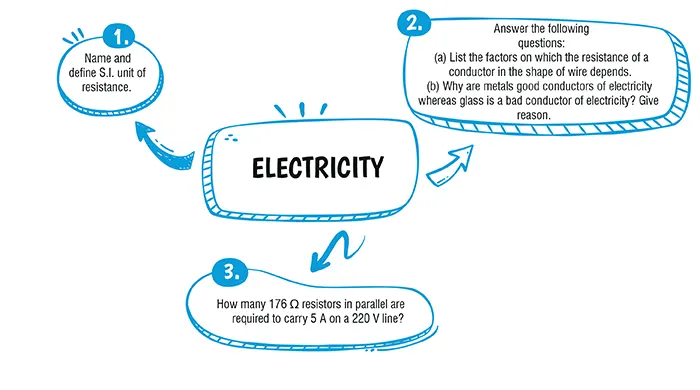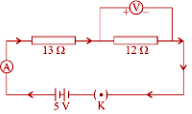Table of Contents


Ans. (b)
Explanation:
Using Ohm’s law, Current,
I = V/R
= 5/ (13+12)
= 5/25
= 0.2 A
So current flowing in 12 Ω resistance = 0.2 A
The potential difference across 12 Ω resistor = IR
= 0.2× 12
= 2.4 V
Ans. (a)
Explanation:
Electromotive force (emf) of the accumulator, E = 10 V
Internal resistance of the accumulator, r = 0.8 Ω
External power supply voltage, V_{ext}. = 150 V\\
Series resistance used for charging, R = 18 Ω
Explanation:
The S.I. The unit of resistance is ohm (Ω).
The resistance of a conductor is said to be 1 ohm if 1 ampere current flows through it when a potential difference of 1 volt is applied across the ends of the conductor.
Explanation: (a) Resistance of a conductor depends directly on its length and is inversely proportional to the area of cross-section.
(b) Metals have free electrons and they move and conduct electricity, whereas glass does not have free electrons and charges to flow as it is an insulator.
Explanation:
Here, Potential difference, V = 220 V, Current, I = 5 A
∴ Resistance, R = \dfrac{V}{I}\\[4.5 bp] \space\space\space\space\space\space\space\space\space\space\space\space\space\space\space\space= \dfrac{220}{5} = 44Ω \\[4.5 bp] Let the number of 176 Ω resistors to be connected in parallel to give an equivalent resistance of 44 Ω be x.
Equivalent resistance of ‘x’ 176 Ω resistance connected
In parallel is \dfrac{176}{x}Ω\\[4.5 bp] \text{But, }\space\space\space\space\dfrac{176}{x} = 44\\[4.5 bp] \therefore \space\space\space\space x = \dfrac{176}{44} = 4 \\
Thus, 4 ressisters of 176 Ω each should be connected in parallel.
| Chapter No. | Chapter Name |
|---|---|
| Chapter 1 | Chemical Reactions and Equations |
| Chapter 2 | Acid, Bases and Salts |
| Chapter 3 | Metals and Non-Metals |
| Chapter 4 | Carbon and its Compounds |
| Chapter 5 | Life Processes |
| Chapter 6 | Control and Coordination |
| Chapter 7 | How do Organisms Reproduce |
| Chapter 8 | Heredity |
| Chapter 9 | Light : Reflection and Refraction |
| Chapter 10 | The Human Eye and the Colourful world |
| Chapter 11 | Electricity |
| Chapter 12 | Magnetic Effects of Electric Current |
| Chapter 13 | Our Environment |
| Chapter Wise Important Questions for CBSE Board Class 10 Science |
|---|
| Chemical Reactions and Equations |
| Acid, Bases and Salts |
| Metals and Non-Metals |
| Carbon and its Compounds |
| Life Processes |
| Control and Coordination |
| How do Organisms Reproduce |
| Heredity |
| Light : Reflection and Refraction |
| The Human Eye and the Colourful world |
| Electricity |
| Magnetic Effects of Electric Current |
| Our Environment |
CBSE Important Questions Class 10
ICSE Important Questions Class 10
CBSE Important Questions Class 10
ICSE Important Questions Class 10